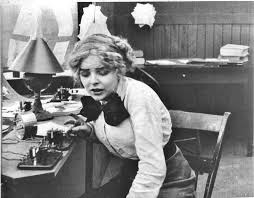Blanche Sweet (1896-1986) may not be as well known these days as Mary Pickford and Lillian Gish, but she is every bit as coquettish and endearing. She also started with Griffith (she made this film at age 15, although she looks at least 19), and she also went on to a long career in film.
Lonedale Operator is reminiscent of The Great Train Robbery and shows how far films had come in the 8 years between the two. Sweet plays the ingenue, the telegraph operator’s daughter who is being wooed by a young train conductor. They flirt, but typical of films from 1911, she rebuffs his kiss. She takes over at the telegraph switch when her father falls ill and refuses the small handgun that she offers him to help secure the station. After a shipment of money for the The Lonedale Mining Company payroll arrives at the telegraph station by train, two hobos who have hidden in the undercarriage hop off the train and try to break into the station to steal the cash. Sweet, alone and besieged inside the station, has some melodramatic moments as she is terrified and faints, but not before she telegraphs for help. Exciting shots ensue of the would-be boyfriend turning his train around and rushing to her rescue. She then awakens and holds off the robbers with a gun until her saviors arrive. But she didn’t have a gun, right? The climactic punchline of the film shows an extreme closeup of the wrench that she faked the thieves into thinking was a gun. The bad guys react with dismay that they have been so fooled. She cuddles with the boyfriend but still won’t kiss him.
Film historians make a lot about the close-up of the wrench as an important moment in film history. But there is a lot more to this film than one close-up. Griffith’s intercutting really builds tension, particularly the alternating shots of the girl in peril and the shots of the young conductor earnestly operating his train as he races to her rescue. The angle at which the shots in the conductor’s booth are filmed is a little jarring and thrusts the audience into the action.
The story is also a little more sophisticated that what movies previously supplied. The frame story of the young conductor trying to get a kiss. The foreshadowing of the girl refusing the gun, only to end up with a gun that you know can’t be a gun, only to have the punchline explode that the gun was really a wrench.
With films like Lonedale Operator (which runs just over 16 minutes), Griffith was getting closer to expanding into feature films. There had already been feature-length movies all the way back to The Story of the Kelly Gang in 1906, but films running over an hour were the exception rather than the rule in 1911. Storefront nickelodeons were not really conducive to showing features. While there was a gradual evolution to what one could consider a modern movie house, it wasn’t really until D. W. Griffith’s own feature The Birth of a Nation became such a runaway hit in the 1915 that the building off dedicated movie theaters took off in a big way in America.


Recent Comments